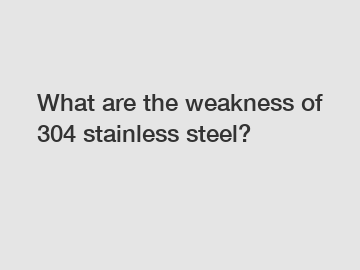What are the weakness of 304 stainless steel?
Stainless steel is widely used in various industries and applications due to its many desirable properties, such as corrosion resistance, durability, and ease of fabrication. One of the most popular types of stainless steel is 304 stainless steel, which is known for its versatility and affordability. However, like any material, 304 stainless steel also has its weaknesses that need to be considered when choosing it for a specific project.
One of the main weaknesses of 304 stainless steel is its susceptibility to corrosion in certain environments. While 304 stainless steel is corrosion-resistant in many applications, it is not suitable for use in highly acidic or chloride-rich environments. In these environments, the passive film on the surface of the steel can break down, leading to localized corrosion known as pitting corrosion. This can cause the steel to deteriorate rapidly and compromise its structural integrity.
Another weakness of 304 stainless steel is its relatively low temperature resistance compared to other types of stainless steel. While 304 stainless steel can withstand temperatures up to 870°C (1600°F) in intermittent service, it is not recommended for continuous use at temperatures above 430°C (800°F). At high temperatures, the steel can become susceptible to carbide precipitation, which can lead to intergranular corrosion and reduced mechanical properties.

Furthermore, 304 stainless steel has poor resistance to abrasion and wear. While it is suitable for many general-purpose applications, it is not recommended for use in environments with high levels of abrasion or impact. In these conditions, the surface of the steel can become worn and damaged, leading to premature failure of the component.
Additionally, 304 stainless steel is not as strong as some other types of stainless steel, such as 316 stainless steel. While it has good tensile strength and hardness, it is not as resistant to stress corrosion cracking as other grades of stainless steel. This can be a concern in applications where the steel is subjected to high levels of stress or fluctuating loads.
Despite these weaknesses, 304 stainless steel remains a popular choice for many applications due to its affordability, ease of fabrication, and overall versatility. By understanding its limitations and selecting the appropriate grade for a specific project, it is possible to mitigate the weaknesses of 304 stainless steel and ensure the success of the application.
In conclusion, while 304 stainless steel has many desirable properties, it also has weaknesses that need to be considered when choosing it for a specific project. Its susceptibility to corrosion in certain environments, low temperature resistance, poor abrasion resistance, and lower strength compared to other grades of stainless steel are important factors to take into account. By understanding these weaknesses and selecting the appropriate grade for the application, it is possible to use 304 stainless steel effectively and ensure the success of the project.
For more information, please visit No.4 Stain stainless steel sheets, Linen Pattern Embossed Stainless Steel Sheet, Corrugated Stainless Steel Sheet Supplier.



Comments
0